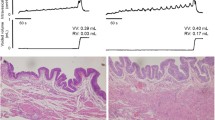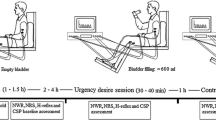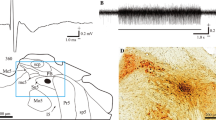Summary
Mechanical or electrical stimulations in the area of the mouth evoke two phases of inhibition in the masseter muscle (early and late inhibitory reflex, also called masseter silent periods). The question whether the afferents of the human masseter inhibitory reflex are nociceptive or non-nociceptive has not yet been settled. We showed that an innocuous stimulus, such as a fine jet of saline directed to the lips of healthy humans, evokes an early and a late masseter inhibitory reflex, similar to those following electrical stimulation. We measured the efferent and afferent delay of the masseter early inhibitory reflex in patients submitted to intracranial stimulation of the motor and sensory trigeminal root, and found that the reflex afferents belong to the intermediately fast conducting fibre group.
Similar content being viewed by others
References
Cruccu G(1986) Intracranial stimulation of the trigeminal nerve in man. I. Direct motor responses. J Neurol Neurosurg Psychiat 49:411–418
Cruccu G, Bowsher D (1986) Intracranial stimulation of the trigeminal nerve in man. II. Reflex responses. J Neurol Neurosurg Psychiat 49: 419–427
Cruccu G, Inghilleri M, Fraioli B, Guidetti B, Manfredi M (1987a) Neurophysiologic assessment of trigeminal function after surgery for trigeminal neuralgia. Neurology 37: 631–638
Cruccu G, Inghilleri M, Manfredi M, Meglio M (1987b) Intracranial stimulation of the trigeminal nerve. III. Sensory potentials. J Neurol Neurosurg Psychiat 50: 1323–1330
Di Francesco G, Nardone A, Schieppati M(1986) Inhibition of jaw-closing muscle activity by tactile air-jet stimulation of peri and intra-oral sites in man. Archs Oral Biol 31: 273–278
Godaux E, Desmedt JE (1975) Exteroceptive suppression and motor control of the masseter and temporalis muscles in normal man. Brain Res 85: 447–458
Goldberg LJ, Nakamura Y (1968) Lingually induced inhibition of masseteric motoneurons. Experientia 24: 371–373
Kidokoro Y, Kubota K, Shuto S, Sumino R (1968) Reflex organization of cat masticatory muscles. J Neurophysiol 31: 695–708
Lund JP, Lamarre Y, Lavigne G, Duquel G (1983) Human jaw reflexes. Adv Neurol 39: 739–755
Meier-Ewert K, Gleitsman K, Reiter F (1974) Acoustic jaw reflex in man: its relationship to other brain-stem and microreflexes. Electroencephalogr Clin Neurophysiol 36: 629–637
Miles TS, Turker KS (1986) Does reflex inhibition of motor units follow the “size principle”? Exp Brain Res 62: 443–445
Miles TS, Turker KS (1987a) Reflex responses of motor units in human masseter muscle to electrical stimulation of the lip. Exp Brain Res 65: 331–336
Miles TS, Turker KS (1987b) Decomposition of the human electromyogramme in an inhibitory reflex. Exp Brain Res 65: 337–342
Ongerboer de Visser BW (1983) Anatomical and functional organisation of reflexes involving the trigeminal system in man: jaw reflex, blink reflex, corneal reflex and exteroceptive suppression. Adv Neurol 39: 729–738
Ongerboer de Visser BW, Goor G (1976) Cutaneous silent period in masseter muscles: a clinical and electrodiagnostic evaluation. J Neurol Neurosurg Psychiat 39: 674–679
Price OD, Dubner E (1977) Neurons that subserve the sensory discriminative aspect of pain. Pain 3: 307–338
Smith A. Moore CA, Weber CM, McFarland DH, Moon JB (1985) Reflex responses of the human jaw-closing system depend on the locus of intraoral mechanical stimulation. Exp Neurol 90: 489–509
Author information
Authors and Affiliations
Rights and permissions
About this article
Cite this article
Cruccu, G., Agostino, R., Inghilleri, M. et al. The masseter inhibitory reflex is evoked by innocuous stimuli and mediated by A beta afferent fibres. Exp Brain Res 77, 447–450 (1989). https://doi.org/10.1007/BF00275005
Received:
Accepted:
Issue Date:
DOI: https://doi.org/10.1007/BF00275005




